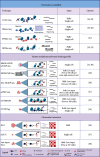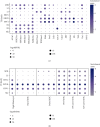Chromatin Regulation in Development: Current Understanding and Approaches
- PMID: 33603792
- PMCID: PMC7872760
- DOI: 10.1155/2021/8817581
Chromatin Regulation in Development: Current Understanding and Approaches
Abstract
The regulation of mammalian stem cell fate during differentiation is complex and can be delineated across many levels. At the chromatin level, the replacement of histone variants by chromatin-modifying proteins, enrichment of specific active and repressive histone modifications, long-range gene interactions, and topological changes all play crucial roles in the determination of cell fate. These processes control regulatory elements of critical transcriptional factors, thereby establishing the networks unique to different cell fates and initiate waves of distinctive transcription events. Due to the technical challenges posed by previous methods, it was difficult to decipher the mechanism of cell fate determination at early embryogenesis through chromatin regulation. Recently, single-cell approaches have revolutionised the field of developmental biology, allowing unprecedented insights into chromatin structure and interactions in early lineage segregation events during differentiation. Here, we review the recent technological advancements and how they have furthered our understanding of chromatin regulation during early differentiation events.
Copyright © 2021 Zi Hao Zheng et al.
Conflict of interest statement
The authors declare no conflict of interests. The data used for analysis were sourced from Gene Expression Omnibus. Search was conducted for human and mouse genomic data with relevant key terms such as “ATAC,” “ChIP-seq,” “ESC,” and “TSC.” Literature search was conducted using PubMed, Google Scholar, Nature, Cell Press, Science Magazine with a combination of keywords such as “Single-Cell,” “Embryogenesis,” “Stem cell differentiation,” “Trophoblast differentiation,” “Histone variant,” “Transposable element,” “Totipotency,” “Transdifferentiation,” and “Histone modifier.” The search results were considered based on novelty, potential impact, and possible applications.
Figures



References
Publication types
LinkOut - more resources
Full Text Sources
Other Literature Sources

